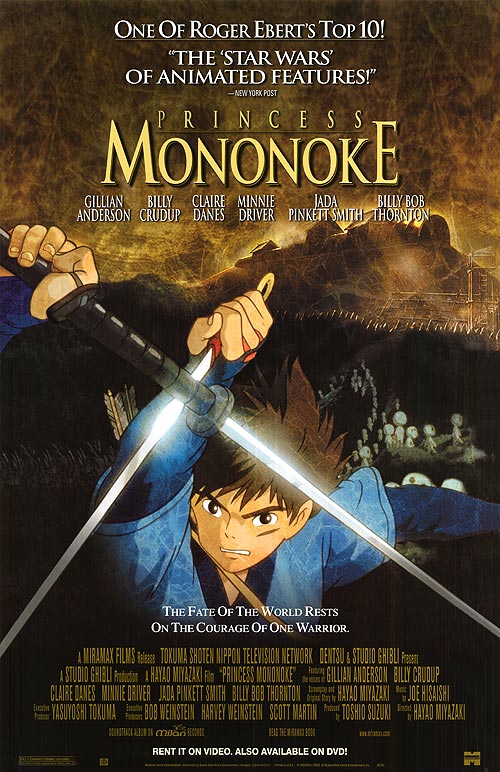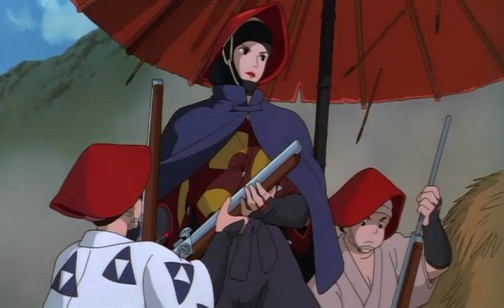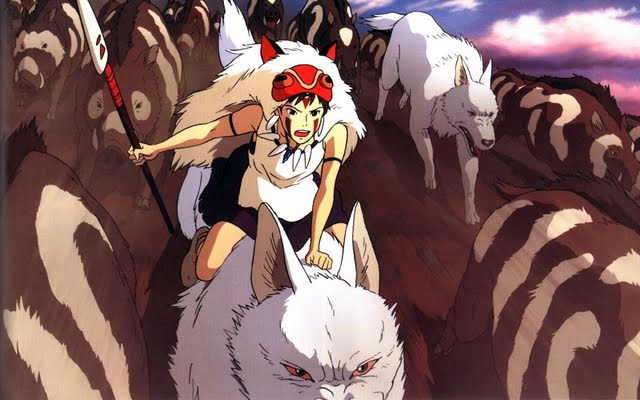It’s probably been a decade since I last watched director Hayao Miyazaki’s classic, but the film’s at-long-last release on Blu-ray is more than enough excuse to revisit this grand story. Set in a Japan taking its first violent, polluted, and uncertain steps toward industry, Princess Mononoke is a complex and ambitious story of humans, beasts, and nature that avoids easy answers and straightforward moral dichotomies, making it an important milestone in animation history.
More than just a nature film
After the story explains its setting–forests have been destroyed, man and beast no longer live in harmony, and spirits are restless–the plot begins with a dark monster leaving corruption and filth in its wake. The tragic creature is a boar god, who has since become a rage-filled demon with worms or snakes pouring and crawling from every orifice. The latter are so numerous that they actually begin to take a form like a giant spider, and they’re more than strong enough to collapse a village watchtower before moving on. Ashitaka, the last prince of his shrunken tribe and our film’s hero, chases the demon from atop his red elk in scenes that look incredible up close and rarely repeat topography.
Ashitaka shoots the demon in the eye with an arrow (the story is much more violent than many of Studio Ghibli’s other films, even Grave of the Fireflies), and the creature’s demonic wound sprays onto the boy himself, cursing him. The intelligent boar spends its last breaths on malice, then instantly decomposes. The young prince’s village looks to the advice of its wise woman, who informs the boy of the nature of his demonic wound. It is a terminal infection, and he must go west, from whence the boar came. Sadly, Ashitaka is effectively exiled from his village and his people–an event that seems to recur throughout the film.
The film’s production values are of the highest quality even from its beginning, setting trademark Ghibli gorgeousness (note especially how the foreground and background animate in horizon shots) against gentle music and easy-to-follow storytelling that waits patiently before adding layers of detail to its main conflict.
A morality story that stands on the strength of its characters
Before long, groups of samurai begin attacking unarmed civilians before turning their attention toward Ashitaka and his elk, Yakul. After a brief but exciting first-person riding sequence, our prince fires off and shoots arrows so hard that he begins tearing people’s arms and heads off. It’s a wonder his unnatural strength doesn’t snap his bowstring; speaking of which, his infection is beginning to spread throughout his arm and to threaten his body. Not being one to enjoy fighting, Ashitaka apologizes for the killing of the samurai–a Japanese take on the concept of the rogue knight?–and his remorse is a nice character-establishing detail that unfortunately gets somewhat lost in some later bits of random action.
Elsewhere, the confident and powerful Lady Eboshi is leading a bunch of people transporting rice back to her relatively modernized community. A sudden and intense fight with a small group of wolves tearing through the crowd ends with several people being thrown into a river and a wolf being bloodily shot and set on fire. The story’s portrayal of Eboshi is at first coldly pragmatic, but she’s easily the film’s most three-dimensional and well-rounded character; her personality shifts smoothly between convenience and compassion while also treating two of her city’s people groups, lepers and brothel girls, with a remarkable humaneness that arguably exceeds that which Ashitaka’s own people give him.
Here Prince Ashitaka is introduced to San, a feral misanthrope with a disturbing past and an important future. While she busily cleans one animal’s wound, another man brings a bit of comic relief as he trembles at the sight of a kodama, a tiny forest spirit. There are many of them, living in and around an enormous and beautiful tree, and they mean no harm. Their lovely home stands in contrast to Eboshi’s iron-forging town, but the latter’s environmental exploitation stems as much from its ruler’s concern for her people as it does from her own ambition. Hence, her desires to fight and conquer feel more fresh as her motives become less arbitrary, even if her ends arguably don’t always justify her means.
The iron town’s people are distrustful of outsiders, a feeling readily and often rightly shared by nearly everyone in the film toward each other. Even as he too can’t afford to let his guard down, not even for San, Ashitaka cares for the well-being of her along with Eboshi and most other individuals, making him a likable if perhaps ordinary cursed hero. His condition, which isn’t set up only to be forgotten about but is a constant source of inopportune flare-ups, keeps him and the movie’s pacing from dawdling.
Environmentalism shouldn’t be a zero-sum game.
As a story with an intended message, some aspects of the film can feel a little too obviously symbolic; Ashitaka’s and others’ demonic curse, for example, serves as a blatantly stated representation of hatred, even as its semi-biological ‘rules’ potentially allow for solutions that Eboshi brings up to no avail. When a fight breaks out between the lady and one of her ideological enemies, Ashitaka physically intervenes and preaches about “what hatred looks like”–a fine lesson that would perhaps have had a better delivery if it were left up to the audience to question, analyze, and understand.
The conflicts among the various human and animal groups leave no clear technology-versus-nature divide. Both groups and their internal factions and squabbles have usually respectable needs and desires that sadly don’t always have optimally satisfying answers. As war becomes more likely, the mood leans less toward epic build-up and more toward inevitable tragedy. Ashitaka’s heroic quest feels believable thanks to his inability to single-handedly provide a way out for everyone’s dilemmas. Moreover, the cynical apes, arrogant boars, at times amoral wolves, and incomprehensibly motivated deities who manage even to frustrate other animals paint a more realistic picture of the world than self-loathingly depicting humans as uncaring monsters offending a godlike environment would have been.
San’s and Ashitaka’s personal interactions take a somewhat predictable turn, but after a sudden set-up, this gets treated with care and thought and isn’t given an easy ending any more than any of the film’s other subplots are. A few scenes feel melodramatic, such as San lashing out at a man she was speaking civilly to only a few moments earlier; likewise, the consistency of Ashitaka’s regard for life comes into question when he drops his habit of apologizing to everyone he is forced to kill. Beyond those minor character-developing quirks and a weird Aliens-esque tendency to showcase most women in at worst a sympathetic light while many men are pointlessly greedy or murderous, this marvelously crafted beauty of a film serves as some of Hayao Miyazaki’s most compelling storytelling to date.
Miyazaki is not one to shy away from truly strange visuals, with the Oscar-winning Spirited Away deserving a special mention, and here such moments are among his arguable best as beautiful and majestic creatures repeatedly mutate into horrifying monsters that arouse pity and terror in equal measure–never to mention that they look incredible in motion, as was the case with Katsuhiro Otomo’s Akira.
Conclusion: A timeless story that stands as a classic.
Princess Mononoke succeeds on so many levels that it’s difficult to know what to praise first–the music, art, and animation are all beautiful, the character designs are distinctive and memorable in the best and worst ways, the story doesn’t stoop to simplistic us-versus-them generalizations, the dialogue dubbing is very well done, and the film’s message and priorities feel far too complicated to limit to a cliche “take care of the environment” sermon. Some scenes do feel a little too “preachy,” but such moments are brief and rare, giving way to a plot that delivers plenty of exciting action as adeptly as it at least tries to seek alternative methods to resolve conflicts.
The film is not appropriate for children–even despite the gore, intense violence, and occasional language, the story and themes might go over younger viewers’ heads (including the implications of the “brothel girls” and the importance of why Eboshi humanizes them in her treatment so well). That being stated, this would be a resounding recommendation for younger teens who can maturely and responsibly handle the adult material, which is always meaningful even when it’s disturbing. This is a movie that deserves to be revered, remembered, and passed down: I don’t remember if I had my driver’s license when I first (or last) saw this film, but I expect I’ll still gladly be watching this with my children someday when they’re ready to earn their own.
Clickety-clickety clackety-clackety-clack
Image sources (property of Studio Ghibli, Toho Company, Buena Vista International)
– Movie poster – source
– Ashitaka, on mount – source
– Nago the boar – source
– Lady Eboshi, armed – source
– San, on mount – source
– Deer god – source
– Nature scene – source







Pingback: Movie Review: Persepolis | Projected Realities